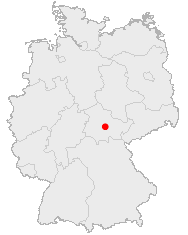Weimar
|
|
| Coat of arms | Map |
|---|---|
| Missing image Weimar-coat_of_arms.png Weimar's coat of arms | 
|
| Statistics | |
| State: | Thuringia |
| District: | Independent city |
| Area: | 84.27 km² |
| Population: | 63,691 (12/31/2002) |
| Population density: | 755.8/km² |
| Elevation: | 208.6 m |
| Postal code: | 99421, 99423-99427 (old: 5300) |
| Area/distance code: | 036-43 |
| Location: | Template:Coor dm. |
| Municipal code: | 16055000 |
| Car designation: | WE
|
| Address of the city administration: | 17 Schwanseestr. Weimar 99421 |
| Website: | www.weimar.de |
Weimar is a city in Germany. It is located at 50° 58 min 6 s north / 11° 18 min 6 s east, in the Bundesland of Thuringia (German: Thüringen), close to the Thüringer Wald to the south, shortly to the northeast of Erfurt, and approximately fifty miles (75 kilometers) southwest of Halle and Leipzig. Its current population is approximately 62,000. The oldest record of the city dates to the year 899.
| Contents |
History
Weimar is one of the great cultural sites of Europe, since it was the home to such luminaries as Bach, Goethe, Schiller, and Herder. It has been a site of pilgrimage for the German intelligentsia since Goethe first moved to Weimar in the late 18th century. The tombs of Goethe, Schiller, and Nietzsche may be found in the city, as may the archives of Goethe and Schiller.
The period in German history from 1919-1933 is commonly referred to as the Weimar Republic, as the Republic's constitution was drafted here while the capital, Berlin, with its streets rioting after the 1918 revolution, was considered too dangerous for the National Assembly to convene.
Weimar was the center of the Bauhaus movement. The city houses art galleries, museums, the German national theatre, and the Bauhaus University. During World War II, there was a concentration camp near Weimar, at Buchenwald, a little wood that Goethe had loved to frequent.
UNESCO selected the city as cultural capital of Europe ("Kulturstadt Europas") for 1999.
On September 3, 2004, a fire broke out at the Duchess Anna Amalia Library. The library contains a 13,000-volume-strong collection of Goethe's masterpiece Faust, in addition to a music collection of the Duchess. An authentic Lutheran Bible from 1534 was saved from the fire. The damage toll measures into the millions of dollars. The number of books in this historic library exceeded 1,000,000, of which 40,000 to 50,000 were destroyed. The library belongs to the UNESCO world heritage, and is one of the oldest public libraries in Europe. The fire, with its destruction of much historical literature, amounts to a huge cultural loss for Germany, Europe, and indeed the world. A number of books were shock-frozen in the city of Leipzig to save them from rotting.
Famous residents of Weimar
- Goethe
- Nietzsche
- Bach
- Hector Berlioz
- Walter Gropius
- Herder
- Wassily Kandinsky
- Paul Klee
- Franz Liszt
- Laszlo Moholy-Nagy
- Friedrich Schiller
- Arthur Schopenhauer
- Richard Strauss
- Richard Wagner
- Christoph Martin Wieland
Districts:
- Ehringsdorf
- Gaberndorf
- Gelmeroda
- Holzdorf
- Kromsdorf
- Legefeld
- Niedergrunstedt
- Oberweimar
- Possendorf
- Schöndorf
- Süßenborn
- Taubach
- Tiefurt
- Tröbsdorf
Twinnings:
Transportation:
It is connected by one motorway and two routes:
Sporting clubs
- TC Weimar 1912 e.V. (http://de.wikipedia.org/wiki/TC_Weimar_1912_e.V.)
External links
- Weimar's official website (http://www.weimar.de/en/)
- Art galleries in Weimar (http://www.augentier.de/kusa/index_en.php)
- Ginkgo Museum, Weimar (http://www.Mythos-Ginkgo.de)
- Deutsches Nationaltheater (http://www.nationaltheater-weimar.de)ca:Weimar
da:Weimar de:Weimar eo:Vajmaro es:Weimar fr:Weimar id:Weimar it:Weimar he:×××××ר nl:Weimar ja:ヴァイマル no:Weimar pl:Weimar pt:Weimar fi:Weimar sv:Weimar zh:魏玛
